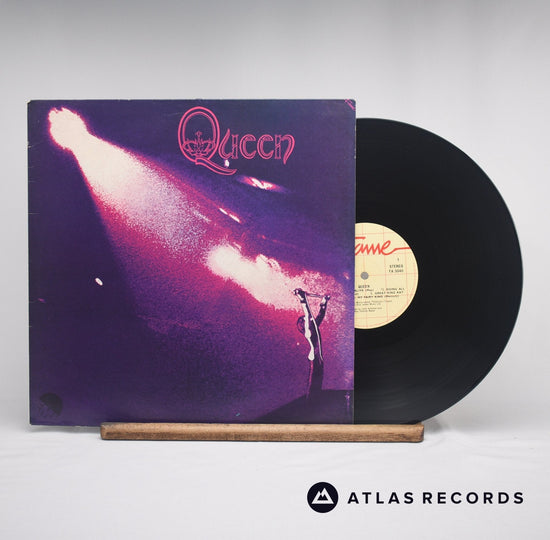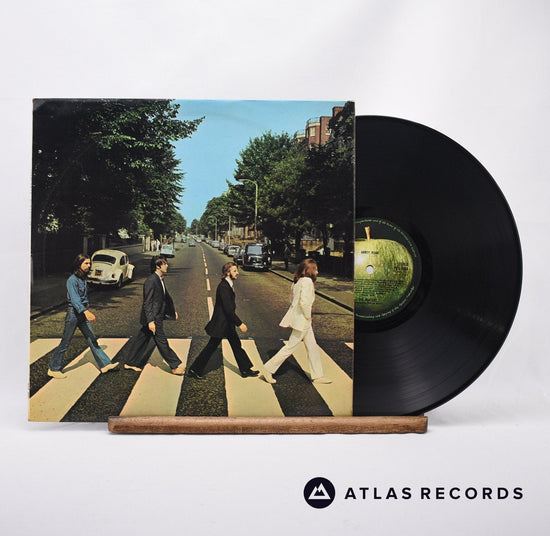Identifying first press Pink Floyd vinyl records is a process rooted in characteristics specific to the sleeve and label of the release. Beginning with 'The Dark Side of the Moon,' UK first pressings are recognised by a solid blue prism on the centre label. 'Wish You Were Here' and 'Animals' have features like angled inner sleeves and unique matrix etchings.
In today's post, we'll take a look at some of the finer details to look out for in order to properly identify your favourite Pink Floyd records.
1 - The Dark Side of the Moon - 1973
Starting off with Pink Floyd's eighth studio album, UK first pressings of The Dark Side of the Moon can be identified by one very clear indicator.
It will have a solid blue prism on the centre label, on both sides. Later pressings have just a blue outline of a prism, with a black centre. It should also come with a black poly-lined inner sleeve, although there's every chance of this having gone missing in the decades since release.
The very best copies of DSOTM will also come with two stickers, two posters and a hype sticker on the front of the sleeve. Not every first press came with the hype sticker, however.
Some very recent or unofficial reissues of DSOTM also come with a solid blue prism on the labels, but it should be fairly clear whether it's an original pressing or a modern reissue. If in doubt, check that the label perimeter text starts with "The Gramophone Co." and that the matrix etchings are A-2 B-2.
2 - Wish You Were Here - 1975
First pressings of Wish You Were Here can be identified by the inner sleeve, which will be cut at an angle on either three or all four of the corners. The second press and beyond have curved corners on the inner.
The very earliest matrix numbers are A-1 B-3, but anything up to B-7 can also be considered a first press, as long as it has the cut corners on the inner.
Another variant of the first press features 'HTM' etched into the matrix, which indicates that the master was cut by Harry T Moss.
The most valuable versions of this album will come with the original black shrink-wrap (complete with hype sticker) and the postcard, which features a man diving into a pool.
3 - Animals - 1976

Pink Floyd's tenth studio album, first pressings of this record are fairly easy to identify because it wasn't reissued (other than a second pressing in the year of release) until a 1997 remaster.
The lack of a barcode on the back of the sleeve is your first indication that you have an original (1977) pressing and from there, it's down to the pressing rings on the label - see the difference in the images below.
The second press was released at the same time as subsequent versions of the first press. All records pressed at EMI have the same single pressing ring close to the centre hole - this is a very useful fact for identifying many different releases!
Much like Wish You Were Here, there is another variant of the first press which features HTM etched into the runout.
4 - The Wall - 1979

Another simple identification, first pressings of The Wall by Pink Floyd can be identified by text (or lack of) inside the gatefold.
Initial versions of The Wall do not feature the band members listed inside the right hand side of the gatefold, and also lack "Written by Roger Waters" as the uppermost piece of text. Check out our comparisons below.
5 - Atom Heart Mother - 1970

There are a handful of different variants of the first pressing of Atom Heart Mother by Pink Floyd, but the key feature across all of them is the lack of a boxed EMI logo above the Harvest logo on the label. It should also feature A-1G B-1G matrices.
The differences between the first press variants are based on details in the publishing credits and the size of the ℗ next to the year on each side. You can dive into these details on Discogs.
6 - Meddle - 1971
Released in 1971 and first reissued in 1974, first pressings of Meddle feature a boxed EMI logo on the label, unlike Atom Heart Mother. This time, the identifying feature comes from the perimeter text at the top of the label starting with "The Gramophone Co. LTD" which became "EMI Records LTD" on later pressings.
All of these variations are a result of label changes through the years, which have ended up being rather useful for identifying pressings. You will have a similar experience when identifying Deep Purple albums, as they also come with green Harvest labels that may or may not feature the EMI logo and EMI Records in the perimeter text.
7 - The Piper at the Gates of Dawn - 1967
Pink Floyd's debut album, there are more than ten different first press variants. These differences focus on tiny details in the text and layout of the releases, so we'll zoom out a bit here and look at the basics.
Released in 1967, there are both stereo and mono versions of this album of varying rarity, with some copies having fetched more than £1000 at time of writing.
All of the earliest versions of this album come with a black label with a blue Columbia logo - later versions feature a silver and black Columbia/EMI label. One extremely rare UK variant was pressed by Odeon, with a copy having sold for over £3000 back in 2012.
Whether your copy is stereo or mono will be evident from which of these words is written on the sleeve and label. There isn't much variation in the values between the two, with both stereo and mono pressings fetching relatively similar prices (2024).
8 - The Final Cut - 1982
A very easy identification, there have been only a couple of UK versions of The Final Cut by Pink Floyd, both pressed in 1983. The Final Cut is Pink Floyd's twelfth studio album.
The repress features a barcode on the sleeve, and the first press does not.
9 - A Saucerful of Secrets - 1968

Back to slightly more complicated identification, A Saucerful of Secrets was also released in the days of mono and stereo pressings.
Much like The Piper at the Gates of Dawn, A Saucerful of Secrets first pressings can be identified by the blue Columbia logo label. Later versions feature the same silver and black Columbia/EMI labels.
Again, like The Piper at the Gates, there are quite a number of variants of the first press which focus in on differences in the label text and alignment, but what is really important is the blue Columbia logo and whether it is stereo or mono, both of which are of similar value.
10 - Obscured by Clouds - 1972

Ending this post with Pink Floyd's seventh studio album, the very first press of Obscured by Clouds can be identified by the matrix etchings SHSP 4020 A-1 / SHSP 4020 B-1. This version was quickly rejected due to too much high-end end EQ and therefore distortion in the pressing.
This issue was quickly corrected with the second pressing (of the first UK issue) which features SHSP 4020 A-2 / SHSP 4020 B-2 matrices.
Both are of similar value, so if you're looking for a first pressing to listen to and enjoy, we'd probably recommend the second 'corrected cut' version. First pressings will also feature "The Gramophone Co. Ltd" in the top rim text of the label, whilst reissues feature "EMI Records Ltd."
























1 comment
Hello
Many thanks, most interesting. I have a collection of Pink Floyd vinyl, might you be interested?
I also have an early collection of Marilyn Monroe vinyl, which may also be of interest.
Regards
Mike Hart